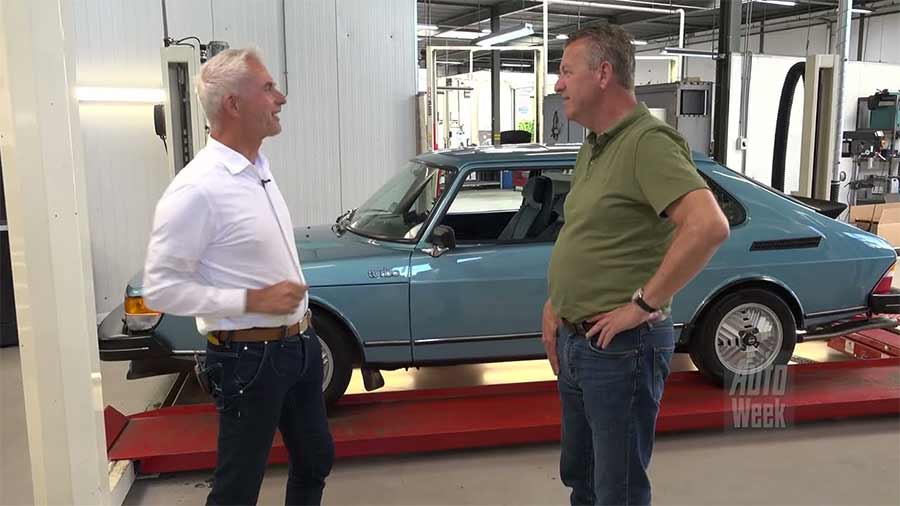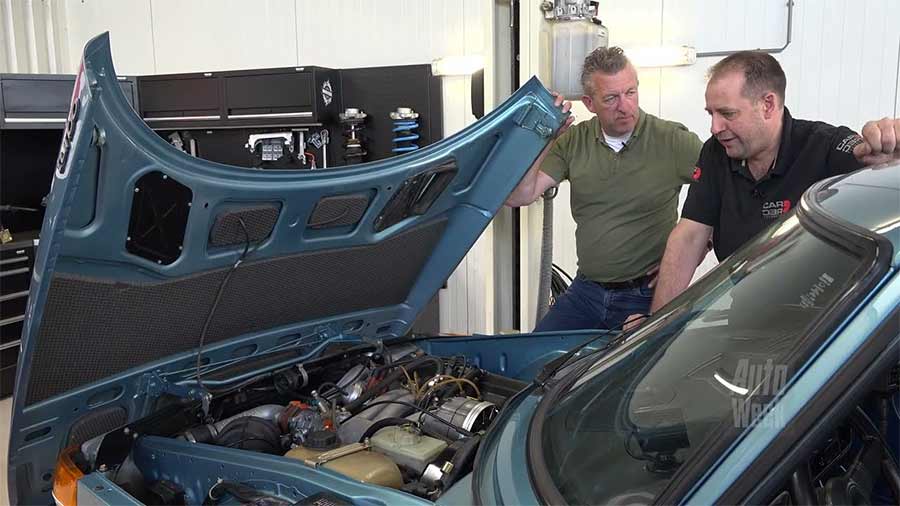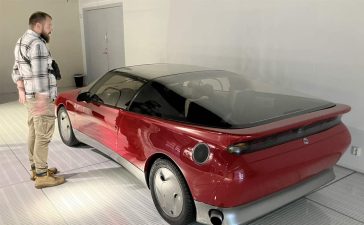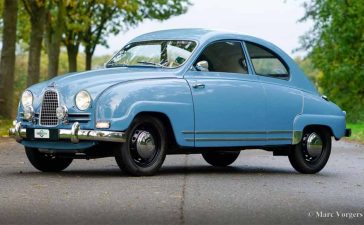Saab people rarely arrive by accident. In Olav Davidse’s case, the path was laid out the moment a light aquamarine Saab 99 GL appeared in his family driveway. That particular shade, somewhere between North Sea sky and oxidized copper, burned itself into his memory. Decades later, the car parked in front of the AutoWeek cameras carries exactly that color – only now it wraps a 1979 Saab 900 Turbo Combi Coupé, one of the earliest blown 900s on Dutch roads.
Olav is 55 today, but he still talks about that first family 99 as if it’s idling just outside the workshop door. His own Saab life started with a 900 V6, not with a turbocharged icon, yet the silhouette of the early three-door Combi Coupé never really left. When a matching aquamarine 900 Turbo surfaced, he didn’t hesitate; the car ticked every personal box he had carried since his youth: correct color, correct body, correct early details. This wasn’t just “a nice example” to add to an existing collection – it was the car his younger self had been sketching in school notebooks.
By the time the AutoWeek “Klokje rond klassiek” team meets him in Soesterberg, Olav is already deep into the Saab rabbit hole. In his shed sit three 900 Turbos from 1979, a 1993 900 Cabriolet and a 1993 900 Turbo Ruby GT, plus a 9-5 Aero as a daily driver. The aquamarine Turbo, however, has a different status. It’s the one that brings his childhood memories of a 99 GL, his father, and the whole idea of Saab as “the clever outsider” together in a single, very tangible object.
That background matters. You can tell from the way he stands next to the car during filming: slightly proud, slightly protective, like someone introducing a close family member rather than a piece of metal. For many of us in the Saab community, that attitude is familiar. A car like this is not a museum piece kept behind a rope; it’s a living link to how Saab chose to engineer cars when marketing departments still lost arguments to the engineers.
The Doctor’s Turbo: An Early Dutch 900 With A Long First Chapter
On paper, this 900 Turbo is “just” a well-preserved early example. In reality, its story is unusually tight and well-documented. Olav bought the car directly from its first owner – a doctor in Groningen – who had ordered it new around the end of 1978. According to AutoWeek, this may very well be the first 900 Turbo delivered in the Netherlands, based on its early registration and chassis details.

The doctor kept the Saab in the family for 41 years. Mileage at the handover in 2020: around 150,000 km – respectable, but nowhere near the six-digit odometer war stories we usually see in the “Klokje rond” series. More interesting is the way that mileage was accumulated. Several readers in the AutoWeek comments immediately recognize the pattern: a doctor with practice at home, a family car that mostly does weekend runs, and long periods of sheltered indoor parking. Suddenly, those 150,000 km over four decades make perfect sense.
When Olav first sees the car, the ingredients are almost suspiciously good. The aquamarine body has been resprayed once, but the shell and floorpan are untouched by a welder, and the dashboard – a classic Saab weak point – is completely crack-free even after 40+ years of UV and temperature cycles. For anyone who has stared at fissures in an old 900 dash, that detail alone is enough to raise an eyebrow.
The way he tells it, there was never a decision to “think about it.” From the moment he knew the car existed, he considered it his mission to buy it. The original Dutch plate, the single-owner history, the color connection to his father’s 99 – it all formed one coherent story. This wasn’t about speculating on future values. It was about rescuing a very specific chapter of Dutch Saab history and giving it a second, carefully controlled life.
A Careful Refresh, Not A Restomod
What followed the purchase was not a radical rebuild, but a deliberate refresh with strict boundaries. Olav wanted the 900 Turbo to look and feel like the car that left the showroom in 1979, with a bit of hidden extra health where it matters.
The body was stripped and repainted properly – not a quick blow-over, but a respray worthy of the car’s origin. Inside, the seats and headlining received new upholstery where needed, keeping the original patterns and feel rather than chasing a modern reinterpretation. The stereo system, however, is a period-correct sign of the times: a serious hi-fi installation with extra gauges on the dashboard – oil pressure, temperature – that emphasize the car’s role as a driver’s machine rather than a static showpiece.
Mechanically, the car has been partially rebuilt rather than fully “over-restored.” The engine and gearbox came out as a unit. Components were inspected, tolerances checked, and the known weak spots on an early 900 – especially the shaft passages in the gearbox casing – were examined closely. In this case, they were still intact, a small victory given how many classic 900s have suffered internal damage there over the decades.
Olav is quick to point out that only one major deviation from factory spec is present: the intercooler. The car now uses a unit from a later 900 Turbo, paired with slightly increased boost pressure. The result, according to him, is a modest bump in power – roughly ten additional horsepower – without sacrificing reliability or driveability. The car remains a period-correct early 900 Turbo to the casual observer, but a Saab enthusiast will notice that this one breathes a bit cooler and stronger than it did in 1979.
Underneath, the braking system has been renewed, including fresh calipers and lines, and the chassis wears Bilstein dampers – a solution many Saab owners will immediately recognize as the sweet spot between factory comfort and tighter modern control. The overall impression on the lift is of a car that has been thoroughly gone through, but never turned into a sterile show car. There are still traces of life, not a polished mirror where the floorpan should be.
Inside The Engine Bay: Classic Saab Engineering On Display
Pop the hood, and you’re looking at a time capsule of Saab’s most idiosyncratic engineering period. The two-liter B-engine sits lengthwise but heavily canted, with the clutch and flywheel at the front and the timing chain buried toward the firewall. The gearbox lives under the engine, sharing its casing with the engine’s oil sump and driven by a triple chain off the crankshaft – a layout that defies almost every front-wheel-drive convention but allowed Saab to package the drivetrain compactly above the front axle.

In the video, Carrec’s technician Dennis Koldewijn walks viewers through this architecture with the calm curiosity of someone who has seen a lot, but still respects the oddities. The clutch, sitting right up front, can theoretically be swapped in under an hour by someone who knows the procedure – something one of the AutoWeek commenters remembers doing in his driveway with nothing more than a workshop manual and stubbornness.
The turbocharged variant of this 2.0-liter engine comes with sodium-filled exhaust valves, different pistons and a camshaft profile designed to cope with boost. Period figures put the output at 145 hp and 235 Nm, with a 0–100 km/h time around nine seconds and a top speed just shy of 200 km/h – numbers that placed the 900 Turbo firmly in sports-saloon territory at the end of the 1970s.
Then there’s the drivetrain tweak that separates Olav’s car from a standard, non-intercooled early Turbo. Because this particular car does not have a five-speed gearbox, he and his specialist chose to lengthen the final drive by changing a gear in the transmission. The aim: lower revs at motorway speeds, making long journeys more relaxed and reducing mechanical stress. The trade-off is a slightly longer first gear, which on paper sounds like a compromise, but in practice doesn’t bother him. With a healthy turbo, the 900 has enough torque to pull it off without feeling bogged down.
Add the Inca wheels, that turbine-like alloy design so deeply associated with the first 99 and 900 Turbos, and the picture is complete. Open the hood of this car and you’re not just looking at a well-preserved Saab; you’re staring directly at the moment when turbocharging went from experimental curiosity to everyday performance tool in mainstream European traffic.
On The Lift With Carrec: Turbo Lag, Chains And Honest Wear
AutoWeek’s “Klokje rond klassiek” format isn’t about static concours cars; it’s about real cars being judged on how they drive and how they’ve survived. This 900 Turbo clears that bar almost casually. During the road test, Dennis notes only one real dynamic flaw: a light thump from the rear axle when the car drops off a speed bump at higher speed. On the lift, the hunt for the source begins, but it’s clear that the issue is minor compared to the car’s overall condition.
What really catches his attention is the way the turbo comes on song a little after 3,000 rpm. There is genuine, old-school turbo lag here – the kind that Saab drivers of the era considered part of the fun. Below that threshold, the 900 behaves like any solid two-liter. Cross the boost line and the car leans into its torque with a surge that feels distinctly mechanical, not filtered by modern electronics. Dennis says it plainly: he likes a “healthy turbo gap”, and this car delivers exactly that experience.
Underneath the front, he points out the double wishbone front suspension, with the handbrake working on the front wheels – another one of those Saab decisions that seem slightly perverse until you remember that the brand also wanted optimal rear brake cooling under heavy load. The Bilstein dampers, fresh steering components and clean, re-protected floorpan all hint at serious time invested in getting the basics right rather than chasing cosmetic perfection alone.
At the rear, the simple live axle located by trailing arms and a Panhard rod shows just how pragmatic Saab could be when the clever solution wasn’t necessary. It’s not exotic, but it’s robust, and on this car it’s remarkably clean. Two new brake pipes, neatly routed and shining under the floor, complete the picture. This is a car that has been restored to be driven, not hidden.
The verdict from Carrec is predictable but still satisfying to hear: a clean bill of health with only minor comments, and a nod to the huge amount of care and detail that’s gone into bringing the 900 back to this level. For a car now 46 years old, that’s an achievement that speaks as much about the owner as it does about Saab’s original engineering.
Saab Culture In The Comments: Safety Legends, Rust Scars And Nostalgia
One of the pleasures of a feature like this is reading the reactions from people who used to own – or still own – similar cars. Under the AutoWeek piece, the comment section fills up with stories that could easily be their own SaabPlanet articles.
There’s the neighbor’s dark green 900 Turbo from the early eighties, remembered as the car that looked fast even at walking pace, with its double rear light clusters and unmistakable roofline. Another commenter recalls the cut-open 99 shell that once hung from the ceiling of a Dutch Saab dealer, showing off the heavy reinforcements in the doors, sills and pillars – a static reminder of why Saab earned its reputation for safety in the pre-airbag era.
Inevitably, someone brings up the Top Gear roof-drop comparison: a 99 falling from around eight feet (about 2.5 meters) and keeping its passenger cell largely intact, while a contemporary BMW 3-series collapses dramatically. The numbers and details may blur over time, but the underlying memory sticks: Saab bodies were built with serious crash protection in mind, long before modern crash structures and multi-airbag systems became industry standard.
Not all memories are romantic. Owners of 900s from the early nineties gently remind each other of how vicious rear wheel-arch rust can be if a car isn’t kept clean and dry – a point that makes Olav’s rust-free shell even more remarkable. One reader mentions his own 1993 900 waiting to go back on the road after rear arch repairs; another is still struggling through repeated engine block issues on a 1981 Turbo, refusing to give up even after multiple rebuilds.
Then there’s the classic cultural stereotype, presented with a smile: Saabs as cars for intellectuals in red corduroy trousers and stubborn non-conformists. One commenter admits he belonged to the second group, not the first, and tells the story of an early EMS with mechanical injection, later converted to carburetors in a desperate attempt to tame recurring faults. It’s a reminder that Saab ownership has always required a certain tolerance for quirks – and that the people who stay with the brand rarely regret that choice.
Watch Olav’s 900 Turbo Come Alive On Video
Text and photos can tell you a lot about a car, but hearing the turbo spool and watching the body move over bumps completes the picture. AutoWeek’s video from the “Klokje rond klassiek” segment does exactly that: you see the aquamarine 900 cruising, boosting, braking, and climbing onto the lift while Dennis talks the audience through what he’s finding underneath.
From behind the wheel, the tester mentions how honest and tight the car feels: steering weight right where you’d expect it, brakes strong and linear, gearbox shifting cleanly with that lightly notchy Saab feel. The turbo whistle is present but not intrusive, a subtle soundtrack behind the music system that someone clearly spent good money on in period.
This video is more than a casual curiosity. It’s a rare chance to see a very early, Dutch-delivered 900 Turbo in near-original specification being driven and inspected in high-definition, with commentary that respects the car’s engineering rather than treating it as a mere curiosity.
When you embed this clip in the article, invite readers to pay attention to small details: the way the Inca wheels fill the arches, how the body barely rolls under load thanks to the refreshed suspension, and how the turbo builds boost in a way that feels mechanical rather than software-managed. It’s those nuances that explain why so many former 900 Turbo owners in the comments say they still miss their cars years after selling them.
Why This 900 Turbo Matters For The Saab Story
On the surface, this is a neat human-interest piece: a Dutch Saab enthusiast buys a well-preserved 900 Turbo from a doctor, restores it carefully, and lets AutoWeek’s experts give it a public health check. Look closer, and it’s something more important for the Saab community.
First, the car itself marks a key transition point in Saab’s history. Introduced in 1978, the original 900 was a direct evolution of the 99, carrying over the Triumph-derived B-engine that Saab had re-engineered into its own unit and later evolving into the H-engine family. The turbocharged versions of these engines turned Saab from a quirky niche brand into a serious performance player, particularly in markets like Sweden, the UK, the Netherlands and the US.
Second, the story underlines how Saab’s engineering decisions – from triple chains to front-mounted clutches and front-wheel handbrakes – built a fan base that appreciates substance over trend. To an outsider, the 900’s engine bay might look needlessly complicated. To someone like Olav, it represents an era when Saab solved problems in its own way, even if that meant teaching every independent mechanic in the country a new set of tricks.
Third, this particular car shows what’s possible when a historically significant Saab ends up with the right owner at the right time. Instead of sliding quietly into neglect after decades as a family workhorse, it gets a second chapter that respects its originality while making it mechanically strong enough for regular use. That balance – between preservation and enjoyment – is exactly where we want more classic Saabs to land.
And now, thanks to owners, clubs and enthusiasts sharing links across forums and social media, this single aquamarine 900 Turbo adds one more thread to the global Saab tapestry.
For those of us who still drive, restore and write about these cars, that’s the real value of stories like this. A 46-year-old turbocharged hatchback from Trollhättan remains relevant not because it’s rare in an auction catalog, but because it continues to move, to be driven hard enough to reveal a faint knock over a speed bump, and to make its owner smile every single time the boost needle swings past three thousand.
Sources for context: The original feature and video were published by AutoWeek in its “Klokje rond klassiek” series on November 14, 2025











